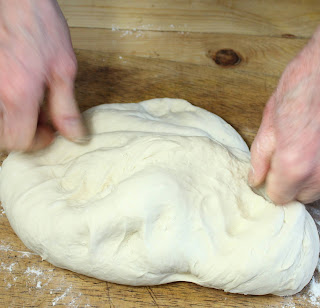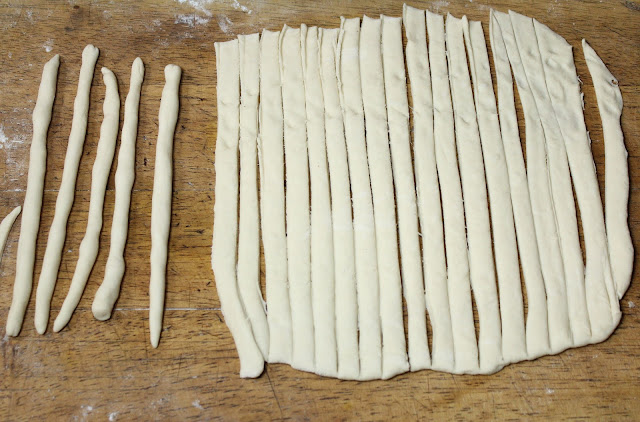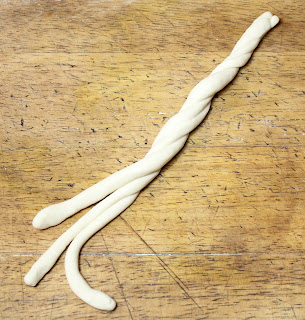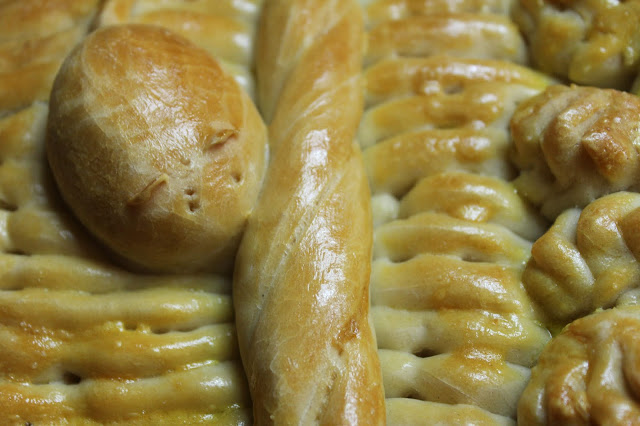When you make one of these decorative loaves you are taking a deep dive into Celtic History, crossing over into the traditions of a Church's Harvest Home and rising up to the present day of Country Wedding Breakfasts and Farmhouse Kitchen Interiors. The word Lammas comes from the Old English hlaf maesse, meaning loaf mass or loaf feast, it took place on the first day of August, traditionally when the wheat harvest started. Farmers' wives would make bread from the first corn (wheat) cut and bring it into the Church to be blessed and thereafter used in the mass.
This festival was adapted from the much earlier Celtic festival of Lughnasadh, which again celebrates the harvest and also the wedding of the Sun to the Earth. The original Lammas loaf was round and marked into quarters. However over the centuries not only did the festival move to the end of the harvest, September, October time depending upon the Sunday nearest to the Harvest moon but the bread offered to and displayed in the Church at the Harvest Festival became more complex. It was baked in the form of a wheatsheaf, complete with harvest mouse. The B&W photograph incorporated into the above image is of my family farm, getting in the sheaves in the 1930s.
INGREDIENTS
This makes a large loaf I had to slightly cut down my loaf to fit the largest tin I have but I'll give you the ingredients for the traditional loaf which is made in a 17" x 13" - 43cm x 33cm baking tray although some of the old wheatsheaf loaves could be double the size!12 cups 1.35kg of white bread flour
2½ teaspoons of coarse Celtic sea salt - crushed or ground
2 teaspoons of sugar
2 teaspoons Dove's Farm (or similar) dried yeast -
about 3 cups 690ml lukewarm water
extra flour for dusting
1 large egg yolk with a pinch of salt added for glazing
oil or butter for greasing the bowl and baking tin/sheet
Oven heated to 425°F - 220°C
MAKING THE BASIC DOUGH
If it is cold weather, I like to warm the bowl with the flour in, at least 15 minutes before I start.
Mix together the flour and salt
Make a well in the centre of the above.
I use the 'Sponge Method':- the yeast is made into a starter by adding in the 2 teaspoons of sugar and around ¼ cup of lukewarm water.
Stir and let stand in a warm place to get foamy and then add it to a well in the flour.
Mix a little of the flour into the well, until it makes a thickish batter.
Let it stand again and after about 5 to 10 minutes it will begin to bubble.
Once bubbling add the rest of the water into the well and then work in the flour and start to knead.
If it feels too sticky after all the liquid and flour are incorporated, then add extra flour.
Turn onto a floured board and knead for around 10 minutes until the dough is smooth and elastic and shape into the form of a ball.Clean the bowl, dry and oil lightly.
Return dough to bowl.
Cover with a damp cloth and leave in a warm room for 2 hours or until it has doubled in size,
At the end of this period, knock back (punch) the dough to remove the gas bubbles.
Turn out onto a floured surface and knead for 2 minutes.
Cover with upturned bowl and let rest for 10 minutes.
WORKING OUT THE PROPORTIONS
A little mathematics:The sheaf is shaped in the form of a mushroom. It is built up of a rectangle and a crescent shape of the dough.
For ease of proportions, divide the dough as follows:
For the base, the crescent and the stalks use half of the whole amount of dough.
From that half the proportions for each are as follows
The base - two eighths
The crescent - three eighths
The stalks and the tie - three eighths
MAKING THE SHEAF BASE, THE CRESCENT AND THE STALKS
Cut the dough in half.
Cover the remaining dough with a damp cloth and set aside.
To shape the sheaf base:
Roll out the dough on a lightly floured work surface with a lightly floured pin into a rectangle measuring approximately 10" x 6" - 25cm x 15cm
To shape the crescent:
Partly roll and partly pat the dough into a crescent shape (the cap of a mushroom).
Place the rectangle onto the greased cooking tray, with its short edge against the bottom short edge of the tray.
Position the crescent on top of the rectangle to form a mushroom shape.
Prick the dough all over with a fork and brush it with some water. This is to stop a crust forming whilst working on the sheaf.
To shape the stalks:
Roll out the piece of dough to a rectangle and divide into 30 equal width strips (I used a rule).
Take each strip, roll into a ball and roll between the palms of the hands to make a thin spaghetti shape, which is long enough to cover the rectangle from its base to the bottom curve of the mushroom (approx. 10" - 25cm).
Three of these pieces will be left over to form the tie or twisted ribbon which will go round the sheaf.
Place the stalks on the rectangle.
Twist the three pieces of the ribbon together and place over the middle section of the stalks, tucking each end under the rectangle.
MAKING THE MOUSE AND THE EARS
Take a small piece of dough from the remaining half. Remember that your mouse will double and get very fat - mine did! (Compare and contrast below)
Take a very small piece of dough for the tail and shape it into a length using the finger tips and the floured board.
Place the tail and then the mouse onto the sheaf.
Shape the wheat ears: divide all the remaining dough into 100 pieces.
Roll each piece into a wheat ear shaped oval.
Taking a pair of sharp scissors and starting at the base of the ear, snip angled shallow cuts all the way down the centre of the ear to the tip.
Then make similar cuts down each side making sure to position these new cuts between those of the centre of the ear.
Place these on the 'mushroom' giving some of them a little curve to make it look like a natural sheaf of corn/wheat.
Continue until the whole mushroom and some of the top of the stalks have been covered.
GETTING READY FOR THE OVEN & COOKING THE WHEATSHEAF LOAF
With a sharp knife make holes in your sheaf. These are to prevent the dough from cracking as it cooks but should follow the natural lines between the stalks and ears, so as not to spoil your design.
Using a pastry brush lightly coat the finished sheaf in the salt and egg glaze.
Place in the oven and bake for 15 minutes.
Remove and add another layer of glaze, whilst reducing the temperature to 325°F - 160°CPlace in the oven for a further 25 minutes or until golden brown.
When cooked the sheaf should easily release from the baking tray.
Leave to cool on the tray.
Then place on a cooling rack.
Slice and enjoy with some raw butter.
If you wish to use your Lammas Loaf as a decoration - wall hanging, then you need to bake it at 250°F - 120°C for 6 hours.
Bon Appétit!
All the very best,
Sue
© Sue Cross 2021
RELATED RECIPES
 Soul Cakes for Samhain
Soul Cakes for Samhain

















No comments:
Post a Comment